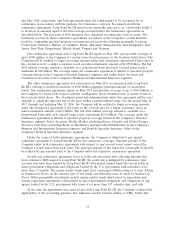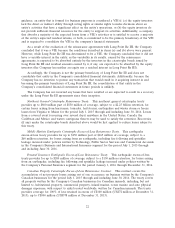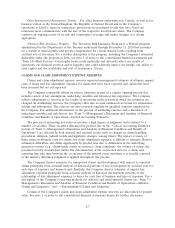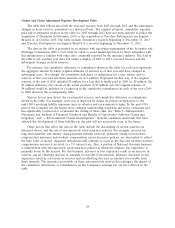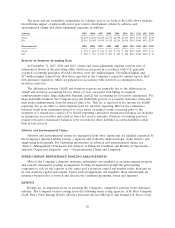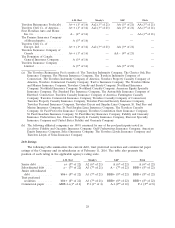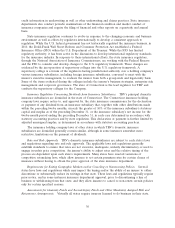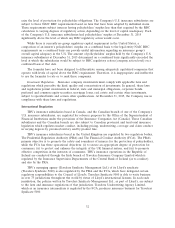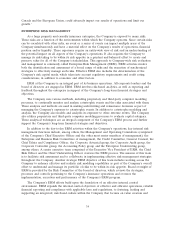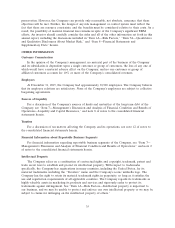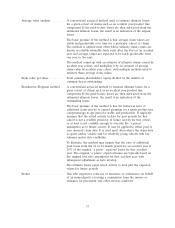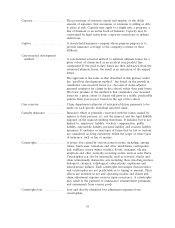Travelers 2015 Annual Report Download - page 30
Download and view the complete annual report
Please find page 30 of the 2015 Travelers annual report below. You can navigate through the pages in the report by either clicking on the pages listed below, or by using the keyword search tool below to find specific information within the annual report.credit information in underwriting as well as other underwriting and claims practices. State insurance
departments also conduct periodic examinations of the financial condition and market conduct of
insurance companies and require the filing of financial and other reports on a quarterly and annual
basis.
State insurance regulation continues to evolve in response to the changing economic and business
environment as well as efforts by regulators internationally to develop a consistent approach to
regulation. While the U.S. federal government has not historically regulated the insurance business, in
2010, the Dodd-Frank Wall Street Reform and Consumer Protection Act established a Federal
Insurance Office (FIO) within the U.S. Department of the Treasury. While the FIO has limited
regulatory authority, it has been active in the discussions to develop international regulatory standards
for the insurance industry. In response to these international efforts, the state insurance regulators,
through the National Association of Insurance Commissioners, are working with the Federal Reserve
and the FIO to consider and develop changes to the U.S. regulatory framework. These changes are
evidenced by the incorporation of supervisory colleges into the U.S. regulatory framework. A
supervisory college is a forum of the regulators having jurisdictional authority over a holding company’s
various insurance subsidiaries, including foreign insurance subsidiaries, convened to meet with the
insurer’s executive management, to evaluate the insurer from both a group-wide and legal-entity basis.
Some of the items evaluated during the colleges include the insurer’s business strategies, enterprise risk
management and corporate governance. The state of Connecticut is the lead regulator for TRV and
conducts the supervisory colleges for the Company.
Insurance Regulation Concerning Dividends from Insurance Subsidiaries. TRV’s principal domestic
insurance subsidiaries are domiciled in the state of Connecticut. The Connecticut insurance holding
company laws require notice to, and approval by, the state insurance commissioner for the declaration
or payment of any dividend from an insurance subsidiary that, together with other distributions made
within the preceding twelve months, exceeds the greater of 10% of the insurance subsidiary’s statutory
capital and surplus as of the preceding December 31, or the insurance subsidiary’s net income for the
twelve-month period ending the preceding December 31, in each case determined in accordance with
statutory accounting practices and by state regulation. This declaration or payment is further limited by
adjusted unassigned surplus, as determined in accordance with statutory accounting practices.
The insurance holding company laws of other states in which TRV’s domestic insurance
subsidiaries are domiciled generally contain similar, although in some instances somewhat more
restrictive, limitations on the payment of dividends.
Rate and Rule Approvals. TRV’s domestic insurance subsidiaries are subject to each state’s laws
and regulations regarding rate and rule approvals. The applicable laws and regulations generally
establish standards to ensure that rates are not excessive, inadequate, unfairly discriminatory or used to
engage in unfair price competition. An insurer’s ability to adjust rates and the relative timing of the
process are dependent upon each state’s requirements. Many states have enacted variations of
competitive ratemaking laws, which allow insurers to set certain premium rates for certain classes of
insurance without having to obtain the prior approval of the state insurance department.
Requirements for Exiting Geographic Markets and/or Canceling or Nonrenewing Policies. Several
states have laws and regulations which may impact the timing and/or the ability of an insurer to either
discontinue or substantially reduce its writings in that state. These laws and regulations typically require
prior notice, and in some instances insurance department approval, prior to discontinuing a line of
business or withdrawing from that state, and they allow insurers to cancel or non-renew certain policies
only for certain specified reasons.
Assessments for Guaranty Funds and Second-Injury Funds and Other Mandatory Assigned Risk and
Reinsurance Arrangements. Virtually all states require insurers licensed to do business in their state,
30



